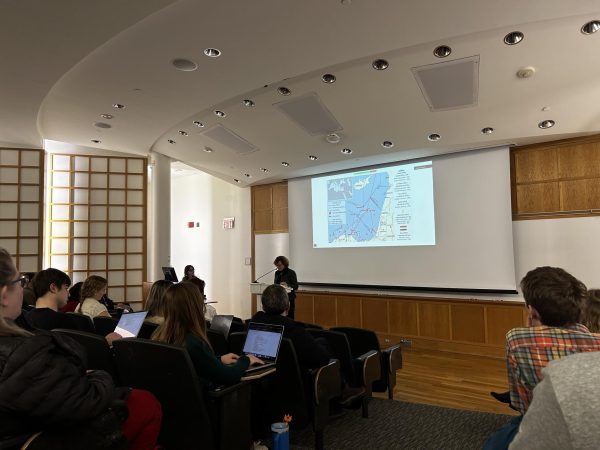So…Where is Colgate?
After the drama, procrastination-driven-guilt and dust of our wild application process had finally settled, we found ourselves members of the Colgate University Class of 2011. The anticipation, elation and excitement we felt was exacerbated by the “Colgate Class of 2011” Facebook.com group, seeing our fellow students up close and personal in New York City rendez-vous or pre-orientation programs and the April visits to the Princeton Review’s (appropriately) thirteenth-most beautiful campus. At the same time, our spirits have been repeatedly dampened by the bane of our beloved college’s existence: an unrecognized name … and lame toothpaste jokes.
Stale wisecracks aside, the media seems to have a very noble impression of our school. Articles listing us among top institutions within specific categories have put us in a favorable spotlight over the past several years, granting a wider scope of people the opportunity to understand our elusive and heavily tradition-oriented Colgate home.
For example, according to U.S. News and World Report’s annual “America’s Best Colleges: 2008” publication, Colgate University ranks at number 17 in the Liberal Arts category, while Men’s Fitness placed us at number 2 in its list of “Fittest Colleges in America 2006”. Even more ego building is the recognition of Colgate University by Kaplan and Newsweek as one of 25 “New Ivies” — a title reserved for the colleges who have demonstrated the longstanding ability to compete with the 8 all-mighty ivy-clad schools, for cr??me de la cr??me of a quality crop of universities.
With all the hype surrounding our beloved school and its superb academia, beautiful people and inevitable attractiveness, as of late, one is led to believe that the proliferation of strong points that our school possesses — and the acclaim they have garnered — may be enough to push us into the world of big-name recognition, yet this can hardly be considered true. The average incoming freshmen student (from a survey of 165 members of the class of 2011) said that, when asked what college they are attending this year, less than half of people recognize their answer (Colgate University) offhand.
Although this may seem to be a far cry from “back in the day”, before propaganda had a measurable influence on the general public’s knowledge of a college’s prestige or household worth, those are hardly the numbers a school comparable to those in the Ivy League should be bringing in. And that’s not even the worst news.
Colgate University is located in New York State — a demographic that 24 percent of students surveyed listed themselves as originating within. About 70 percent of people who asked what school the surveyed students from New York were attending recognized the name “Colgate University”, as would be expected, considering it is within their borders. Students from the New
England states (excluding New York State) took a 19 percent slice of the “Surveyed Freshman” pie, with 70 percent success at name recognition. The Mid Atlantic (18 percent of surveyed students), Midwest (9 percent), South Eastern (7 percent) and West/Southwest (14 percent) sections of the United States had poor ‘Gate recognition at 50 percent, 25 percent, 15 percent and 20 percent, respectively.
Now chew on this: as we break the students into groups, an uneven provincial distribution of student applicants appears to be a leading problem — consistent with the obvious ignorance of the majority of the United States. According to the Colgate University website, 61 percent of applicants came from the 13 states comprising the New England and Mid-Atlantic sections, while 26 percent of applicants came from the 37 Midwestern, Southeastern, and West/Southwestern states. International students contributed the remaining 13 percent of applicants.
What this trend demonstrates is that the farther away from New York a person is, the less likely they are to recognize and, thus, apply to Colgate. One resulting dilemma is that the Office of Admissions, in their continual effort to increase geographical diversity (for reputation and statistical reasons), must accept the best, and then select possibly substandard talent from a sparse pool of applicants — especially in states such as Hawaii, where the average number of applicants to Colgate is inevitably low. This presents itself as a glaring problem because it limits the potential for the college’s growth into a top-notch university.
Let it be known that reputations are built through the passing of information from authoritative sources (such as guidance counselors, popular publications) over an extended period of time, to the na’ve public, which includes, among others, nervous mothers, spastic overachievers and retired old people whose idea of “good colleges” is usually outdated.
Because the core of advisable adults around us tends to stick to deep seeded prejudices, and because Colgate’s worthiness is a newly public concept, it has not been able to penetrate the upper echelon of America’s reputable schools. For students beyond the Northeastern-most states, Colgate has largely remained a hidden treasure.
So this year, as we haul our thousand-pound luggage up the perfectly manicured hills of Colgate University, just remember that each of us are toting the expectations and well-wishes of vastly differing percentages of the global community.
What we must do now to remedy the situation is act in ways that will force the Ivy-league loving grannies of the world to open their toothpaste-jaded eyes, and produce achievements that will leave the unfortunate Colgate University-devoid majority wishing they had had the sense to make Gate House their home.





